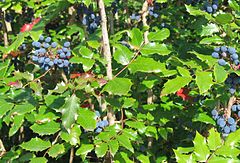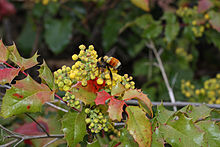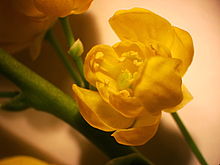- Oregon-grape
-
Mahonia aquifolium
Oregon-grape
Scientific classification Kingdom: Plantae Division: Magnoliophyta Class: Magnoliopsida Order: Ranunculales Family: Berberidaceae Genus: Mahonia Species: M. aquifolium Binomial name Mahonia aquifolium
(Pursh) Nutt.Oregon-grape (Mahonia aquifolium, Berberidaceae) is an evergreen shrub related to the barberry. Some authors place Mahonia in the barberry genus, Berberis. The Oregon-grape is not related to true grapes, but gets its name from the purple clusters of berries whose color and slightly dusted appearance are reminiscent of grapes.
Contents
The name
The name is often left un-hyphenated as Oregon grape, though doing so invites confusion with the true grapes. Some writers avoid this confusion by using "Oregon grape-holly", or "Oregon holly-grape" as a vernacular name for any species of Mahonia. It also occasionally appears in print as Oregongrape. There are several common species of Oregon grape, many with numerous cultivated varieties (cultivars). Among these are Tall Oregon Grape (Mahonia aquifolium), Cascade, Low, or Dwarf Oregon grape, (M. Nervosa), Creeping Oregon grape (M. repens).
The botanic name aquifolium means that the leaf is holly-like (from the Roman name for holly, aquifolium, 'prickly leaved').
Description
The plant grows to 1–5 m (3 ft 3 in–16 ft 5 in) tall. Its leathery leaves resemble holly and the stems and twigs have a thickened, corky appearance. The flowers, borne in late spring, are yellow.
Oregon-grape is used in gardens and natural landscaping similarly to barberry, as a plant suited for low-maintenance plantings and loose hedges. Oregon-grape is resistant to summer drought, tolerates poor soils, and does not create excessive leaf litter. Its berries attract birds.
The small purplish-black fruits, which are quite tart and contain large seeds, are included in smaller quantities in the traditional diets of Pacific Northwest aboriginal peoples, mixed with Salal or another sweeter fruit. Today they are sometimes used to make jelly, alone or mixed with salal.[1] Oregon grape juice can be fermented to make wine, similar to European barberry wine folk traditions, although it requires an unusually high amount of sugar.[2] The inner bark of the larger stems and roots of Oregon-grape yield a yellow dye; the berries give purple dye.[3] As the leaves of Oregon-grape are holly-like and resist wilting, the foliage is sometimes used by florists for greenery and a small gathering industry has been established in the Pacific Northwest.
Distribution
Mahonia aquifolium is a native plant on the North American west coast from British Columbia to northern California, occurring in the understory of Douglas-fir forests and in brushlands. It is the state flower of Oregon.
In some areas outside its native range, Oregon-grape has been classified as an invasive exotic species that may displace native vegetation.[4][5][6][7]
Traditional use
Some Plateau Indian tribes used Oregon-grape to treat dyspepsia.[8] The plant is used medicinally by herbalists. Oregon-grape root is commonly used medicinally as an effective alternative to the threatened goldenseal.[citation needed] Both plants similarly contain the alkaloid berberine, known as an anti-inflammatory and anti-bacterial used in the treatment of infection.[9][unreliable source?]
Certain extracts from Mahonia aquifolium may be useful in the treatment of inflammatory skin diseases such as eczema and psoriasis,[10][11][12] although side effects include rash and a burning sensation when applied.[10]
Recent studies indicate that M. aquifolium contains a specific multidrug resistance pump inhibitor (MDR inhibitor) named 5'-methoxyhydnocarpin (5'-MHC) which works to decrease bacterial resistance to antibiotics and antibacterial agents.[13]
See also
References
- ^ Pojar, Jim; MacKinnon, Andy, eds (1994). Plants of Coastal British Columbia: including Washington, Oregon & Alaska, rev. ed.. Vancouver: Lone Pine Publishing. p. 95. ISBN 978-1-55105-532-9.
- ^ Henderson, Robert K. (2000). The Neighbourhood Forager. Toronto, Ontario: Key Porter Books. p. 111. ISBN 1-55263-306-3.
- ^ Bliss, Anne (1993). North American Dye Plants, rev. and enl. ed.. Loveland, Colorado: Interweave Press. p. 130. ISBN 0-934026-89-0.
- ^ Introduced Shrubs of Birmingham and the Black Country
- ^ North Carolina Botanical Garden / Conservation / Plants to Avoid in the Southeastern United States
- ^ Plants to Avoid in the Southeastern United States Tennessee Invasive Exotic Plant List
- ^ TN Invasive Exotic Plant List
- ^ Hunn, Eugene S. (1990). Nch'i-Wana, "The Big River": Mid-Columbia Indians and Their Land. University of Washington Press. p. 352. ISBN 0-295-97119-3.
- ^ Howstuffworks "Oregon Grape: A Profile of an Alternative Medicine"
- ^ a b Donsky, Howard; Don Clarke. "Relieva, a Mahonia Aquifolium Extract for the Treatment of Adult Patients With Atopic Dermatitis". http://www.americantherapeutics.com/pt/re/ajt/abstract.00045391-200709000-00008.htm;jsessionid=HnrPMH6R3JhTFQNQphZtJqdp7608hvDvWLt5sm4Wj7pW52SdRL4W!1821113646!181195629!8091!-1. Retrieved 4 November 2007.
- ^ Rackova L, Oblozinsky M, Kostalova D, Kettmann V, Bezakova L (2007). "Free radical scavenging activity and lipoxygenase inhibition of Mahonia aquifolium extract and isoquinoline alkaloids". J Inflamm (Lond) 4: 15. doi:10.1186/1476-9255-4-15. PMC 1994948. PMID 17634120. http://www.pubmedcentral.nih.gov/articlerender.fcgi?tool=pmcentrez&artid=1994948.
- ^ Bernstein, Steve et al.. "Treatment of Mild to Moderate Psoriasis with Relieva, a Mahonia aquifolium Extract-A Double-Blind, Placebo-Controlled Study". http://www.americantherapeutics.com/pt/re/ajt/abstract.00045391-200603000-00007.htm;jsessionid=Hnyhk0cdJylLgL8fyNyYdpmy1WpycJvHGpLKFWpfFhX849clNk8j!1821113646!181195629!8091!-1. Retrieved 4 November 2007.
- ^ Stermitz FR, Lorenz P, Tawara JN, Zenewicz LA, Lewis K (February 2000). "Synergy in a medicinal plant: antimicrobial action of berberine potentiated by 5'-methoxyhydnocarpin, a multidrug pump inhibitor". Proc. Natl. Acad. Sci. U.S.A. 97 (4): 1433–7. doi:10.1073/pnas.030540597. PMC 26451. PMID 10677479. http://www.pubmedcentral.nih.gov/articlerender.fcgi?tool=pmcentrez&artid=26451.
External links
- The Oregon Grape in "Our State Flowers: The Floral Emblems Chosen by the Commonwealths", The National Geographic Magazine, XXXI (June 1917), pp. 481–517.
- Mahonia aquifolium images at bioimages.vanderbilt.edu
Medicinal use
- Medical Uses for Oregon Grape from howstuffworks.com
- Mountain Grape from Botanical.com
Categories:- Mahonia
- Flora of the West Coast of the United States
- Flora of the Northwestern United States
- Flora of British Columbia
- Flora of Oregon
- Symbols of Oregon
- Flora of California
- Flora of Idaho
- Traditional Native American medical plants
- Medicinal plants
- Garden plants of North America
- Drought-tolerant plants
- Bird food plants
- Butterfly food plants
Wikimedia Foundation. 2010.


